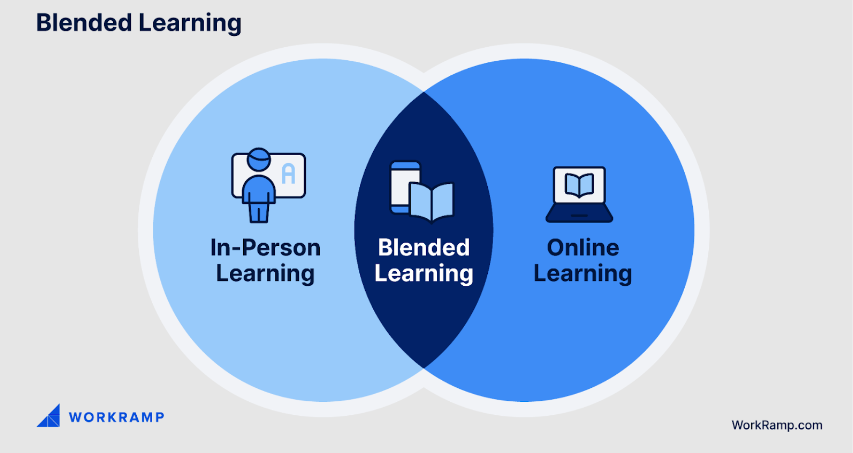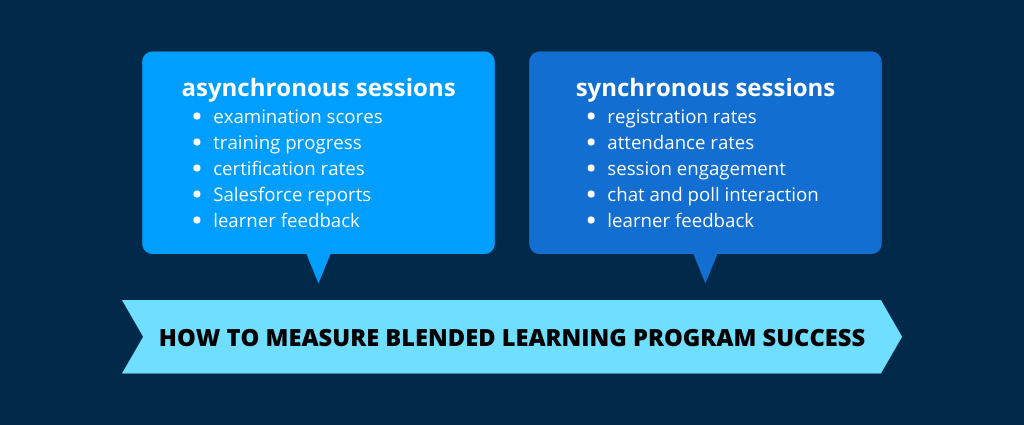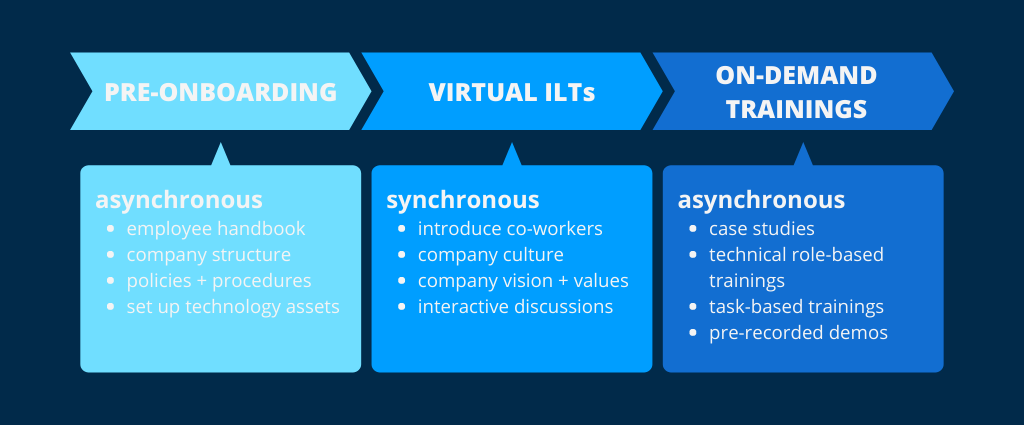The Benefits of Blended Learning
Michael Keenan | WorkRamp Contributor
View bioLearning Tips Straight to Your Inbox
Online learning has become a popular alternative to in-person training. Digital learning offers many advantages, including lower training costs and better employee retention.
However, many organizations worry it won’t provide the same value as traditional classroom training. Instead, instructor-led training (ILT) thrives because users have access to trainers on an ongoing basis through face-to-face support and instruction.
Corporate training takes on a new dimension with blended learning. Organizations can now offer virtual instructor-led training (VILT). This approach allows L&D teams to provide workers with live, synchronous learning experiences and self-paced and on-demand materials.
Talent shortages affect 70 percent of companies. So what is the best way to close that gap? Providing learning programs that help new hires and employees expand their knowledge, refine their skills, and be more productive.
In this post:
What is blended learning?
Blended learning, also known as hybrid learning, is an approach to training that relies on synchronous and asynchronous instruction. Any training incorporating self-guided, online instruction with live or virtual instructor-led training (VILT) falls into the blended learning category.
Blended learning integrates eLearning tools and techniques with traditional teaching methods. A blended learning environment combines multiple approaches, including self-paced, collaborative, trainer-support learning, or traditional classroom teaching.

Even in an online-only environment, where in-person events are limited, organizations can still capitalize on the benefits of blended learning by developing virtual blended learning programs. In this guide, we’ll discuss the benefits and challenges of blended learning, tips to build a virtual blended learning program, and share guidance on measuring program success.
Blended learning combines asynchronous and synchronous techniques
As we’ve covered in previous posts, instructor-led training and asynchronous learning models are incredibly effective in onboarding new employees and executing continuous learning initiatives. Still, each has its unique strengths and weaknesses. While Instructor-Led Training is ideal for covering topics that require a physical demonstration, practicing interpersonal skills, and real-time facilitator feedback, it can be challenging to scale and schedule for large audiences.
With ILT, there are also concerns about employee engagement and information retention—remember that 20-minute sessions (or less) are recommended for online courses to sustain learners’ attention.
Though ideal for empowering flexible learning, breaking down complex topics, and repeatability, asynchronous learning does have its drawbacks. Without peer and instructor contact, asynchronous learning may not be preferred for interpersonal topics or training enhanced with interactive practice and real-time feedback.
Hence, the appeal of blended learning—by using an LMS to develop blended learning opportunities, facilitators and learners can reap the benefits of both ILTs and asynchronous learning, resulting in the best possible training program for your company.
Thanks to learning platforms and technology, you can use the flipped model to combine synchronous and asynchronous techniques. The flipped model or flipped classroom involves moving instruction from a group learning space, like a classroom, to an individual learning space. Whether you use the flipped model for synchronous or asynchronous instruction, strive to create an interactive learning environment that engages participants.
Blended learning in corporate training
Corporate training initiatives begin with culture. Organizational culture is the collection of values, attitudes, and beliefs that guide behavior. Organizations must prioritize learning and professional development to maintain a competitive edge and decrease turnover.
A blended learning approach can help you:
- Implement engaging employee onboarding programs
- Improve new hire productivity
- Boost employee retention
- Identify and close skill gaps
- Share knowledge between employees, teams, and partners
With virtual demonstrations and real-time trainer feedback, organizations can now offer engaging corporate training for many purposes: onboarding, sales, leadership development,, customer training, and more.
Take, for example, a virtual blended learning onboarding program with objectives around teaching the company’s vision and goals, helping new hires understand their roles and responsibilities, and acquainting them with the company culture and other departments.
Start learners off with asynchronous pre-onboarding, which might include bite-sized pieces of information about the company’s structure and technology assets. Virtual ILT sessions are great for the new hires’ first few days, and sessions may look like this:
- Introduce coworkers
- Generate interactive discussions around company culture
- Demonstrate the technical training in which the learner is sure to have follow-up questions
Blended learning examples in corporate training
To approach blended learning effectively, determine your desired training outcomes and the types of sessions that best accomplish them. The end goal depends on the type of training you intend to provide.
Most training follows a similar theme:
- Asynchronous introductory material with microlearning and gamification elements
- Virtual instructor-led training sessions for clarifying concepts and discussing case studies
- 24/7 access to training and resources on demand
Here are a few examples of blended learning in the corporate setting.
Onboarding
An onboarding program can differentiate between a successful new hire and one that fails. Seventy percent of employees with exceptional onboarding experience say they have the “best job ever.” In addition, an effective onboarding program can help new hires feel welcomed and increase their productivity.
A blended learning onboarding process looks like this:
- Asynchronous pre-onboarding. This can include information about the company structure, procedures, and setting up the tech stack.
- In the first few days, provide virtual instructor-led training programs focused on company culture. In addition, you can introduce coworkers and demonstrate any technical training.
- Finally, you can plan role-based training and case studies asynchronously in your learning management system (LMS). As employees progress in their careers, they can revisit material and use it as a resource.
Sales
Maintaining your competitive edge, supporting customers, and winning new business is all possible with sales training. In addition, an effective learning program can help your salespeople deliver ongoing value for your business.
For sales training, you could use a blended learning approach like this:
- Create a core learning module covering negotiation, customer interaction, strategic prospecting, and relationship-building topics. Gamified challenges, expert-led video lessons, and quizzes are effective methods of helping users reach their learning objectives.
- Implement VILT sessions that cover role-playing and scenario-based learning. After the session, you can share any assets (presentations, tips, guidelines) as downloadable resources.
- Provide one-on-one coaching to reps. Also, moderated thread conversations where team members can interact and share knowledge would be a good option.
- Set up an on-demand training portal where reps can access resources.
Compliance
Compliance training can protect you from lawsuits and mitigate unknown risks. It may not be the most exciting business element, but you cannot operate without it.
Employees, partners, and customers must comply with corporate policies, regulations, laws, and accreditation requirements. As policies change regularly, it’s essential to keep everyone informed.
Taking a blended learning approach to compliance training looks like this:
- Develop a self-serve learning module covering ethics and compliance for each employee’s role. Make videos short and interactive to help learners retain information. You can use interactive scenarios and real-life stories to make concepts such as data protection and privacy training more relevant.
- Schedule live virtual training sessions to discuss concepts, scenarios, and case studies to demonstrate the effects of non-compliance.
- You can track online course progress with an LMS and help learners if they get stuck.
- Add expert-led webinars and guidelines for each training to the on-demand portal. Upon completion, award certification to each participant.
What are the key concepts of blended learning?
A blended learning strategy offers the best of both worlds and uses the following concepts from traditional classroom training:
- Instructor-led presentations in real time
- Content selected by the instructor
- Interaction between users, peers, and instructors
- Participants and instructors can have an open dialogue and receive real-time feedback
A blended learning experience draws on the following concepts of self-paced instruction:
- Users can participate anywhere and at any time
- Individuals can work through course content at their own pace
- Participants can join virtual groups around a specific topic or skill level
The advantage of blended learning methods is that it allows for both exploratory and structured learning. Users can complete coursework with a fixed scope and sequence like formal education textbooks.
Explorative learning also allows participants to engage in real-time discussions with experts, generating new ideas and knowledge. Furthermore, they can collaborate with peers and take part in key decisions during the process.
Why is blended learning ideal for corporate training?
Lower cost, higher training ROI
It takes time to create learning content, whether self-paced or not. However, blended learning requires fewer instructors and physical space than other methods.
On-demand and virtual classroom programs still require instructor fees, but you can save significantly on:
- Airfare and mileage costs for attendees from out of town
- Hotel costs
- Rental prices for meeting rooms
- Costs of meals
Organizations can scale training globally with blended learning. In on-demand and virtual classes, you can record sessions, give presentations, create polls, and check attendance for learners everywhere at less cost.
Improves training effectiveness
All industries require ongoing training. It’s a waste of time and money if learners don’t retain or apply the skills they learn. In addition, blended learning programs help improve training effectiveness in ways other learning methods can’t.
You can, for example, use blended learning to:
- Offer material through various training modes, such as multimedia, virtual instructor-led training, gamification, and workshops. This can lead to more student engagement and boost knowledge retention.
- Provide learners with real-time feedback from instructors. Sixty-five percent of employees say they want more feedback from their employers. With blended learning programs, instructors can provide users instant feedback that deepens their understanding of the material.
- Use learning technology to your advantage. A learning management platform allows you to create personalized training programs, plan VILT sessions, and track progress. By doing so, you can identify areas for improvement for users.
Blended learning humanizes corporate training in a digital-first world. Students can meet face-to-face with instructors online, improving the effectiveness of their training.
Enables self-paced learning
Participants can progress at their own pace with self-paced learning, complete assignments on their own time, and go from lesson to lesson as they please. There are several advantages to blending learning, including:
- It can increase interest and corporate value of training
- Employees can retain more knowledge
- Users can adapt their learning styles
Your organization can quickly implement self-paced learning courses with software like an LMS. With a learning management platform, you can create and host materials in one place, where employees can access them whenever possible. In addition, the blended learning approach allows you to record live events and publish them in your LMS for self-paced users to watch.
Promotes collaborative learning
According to a recent study, 91 percent of L&D pros believe that teams that learn new skills together are more successful. In collaborative learning, people work together as a team, and this approach helps team members solve problems, complete tasks, and learn new concepts in a group setting.
Various social learning theories, such as Vygotsky’s theory of social development, suggest that social interaction is key to acquiring knowledge and meaning.
A blended learning approach includes social elements such as:
- Instruction in small groups
- One-on-one meetings with teachers and learners
- Workshops and classes for groups
- Real-time messaging on Slack or Microsoft Teams
Connecting with other people is enjoyable for most people. The benefits of blended learning include chatting about courses, working on group projects, and supporting each other.
Blended learning best practices
Whether you’re launching your first learning program or your fifth, keep these best practices in mind:
- Inform users about blended learning. Provide team members with a schedule of all course activities and explain how they relate to blended learning. For example, label lessons as “live events” or “group workshops” so users know what to expect.
- Communicate with participants through your LMS. In one study, students preferred that instructors communicate through a single channel rather than multiple channels, such as announcements, emails, and chat threads.
- When possible, keep self-paced lessons under 15 minutes. Self-paced classes can take longer than instructor-led lessons. During video or audio lessons, participants often pause to take notes or repeat sections. The longer the class, the more likely someone is to drop out midway.
- Give credit for on-time completion of online materials. Engage employees in learning by adding interactive elements. A few examples are rewards, completion points, and badges. As a result, learners are also held accountable for completing class materials online.
- Use active learning techniques. Face-to-face interaction with instructors is one of the unique features of blended learning. Discuss real-world applications of the material, practice problems, and facilitate discussions between participants during this time.
- Integrate feedback into courses. Allow users to provide feedback on their experience. Understanding how long students take to complete online activities, their use of face-to-face time, and any concerns or questions they may have about the lesson plans can help you adjust courses accordingly.
- Invest in intuitive learning technology. As of 2021, 90 percent of companies use an LMS, up from 84 percent in 2020. You’ll need a flexible, easy-to-use system to run a successful blended learning program. Course material should be easily accessible, and students should be able to adjust the speed and volume and navigate through courses without technical difficulties
Measuring what matters
As with any training program or learning initiative, facilitators should implement systems to measure the effectiveness of blended learning programs. The most efficient and objective way to assess program performance is to base the analysis on specific business goals. So, if your blended learning program is designed to equip your sales team with the skills needed to drive more revenue, you should monitor changes in average deal size following the training.
One of the benefits of virtual blended learning programs is the ease of measuring program success within an LMS. For asynchronous sessions, LMS dashboards provide clear metrics on program scores, outcomes, and even live information on learner progress—LMS tools like WorkRamp even integrate with Salesforce, making it simple to gather performance data.
Virtual ILTs are perhaps easier to evaluate than in-person sessions—facilitators have constant insight into program engagement with interactive elements like polls, chats, and real-time attendance statistics. Of course, facilitators should also ask participants for feedback upon completing a blended learning program.

Blended learning LMS
Citrix reports that 88 percent of employees prefer organizations that use the latest technology to enable learning. With the latest employee training software, you can streamline your blended learning training program and attract the best talent.
Using an LMS, you can provide self-paced and virtual instructor-led training for topics that require instructors. You can use the same platform to schedule online training sessions and deliver them online.
An LMS can also enable blended learning in the following ways:
- Monitor employee performance and assist when necessary
- Deliver targeted, flexible corporate training programs tailored to learners’ needs
- Provide face-to-face, instructor-led training that provides personal feedback
- Provide opportunities to share knowledge and materials
- Offer online teaching assistants who are available to help during office hours or 24/7
- Add game-like elements to the learning process, such as interactive interfaces, badges, leaderboards, and contests
- Integrate with other tools like Zoom, Slack, Salesforce, BambooHR, and more
“WorkRamp allows us to deliver internal employee and external customer and partner training – all in one platform. It’s incredibly easy for trainers and reps to pick up, bolsters organizational agility by centralizing training content in one system, and has all the enterprise features that allow us to scale confidently and quickly.”
-Nadia Provencio, Director of Global Training and Operations, 8×8
Including blended learning in your L&D programs
When it comes to corporate training, self-directed learning can be challenging and uncertain. However, combining blended learning with facilitator training can improve knowledge retention and application. Using an LMS for corporate training will help you deliver targeted training that expands your teams’ skills and impacts your bottom line.
Discover how you can use WorkRamp to create blended learning programs and a learning culture at your organization. Contact us to request a free personalized demo.
Complete the form for a custom demo.
Recent Posts
- Top LMS Integrations That Power Smarter, Faster Learning July 2, 2025
- Introducing WorkRamp Analytics Studio: Unlocking Your Data Insights with AI June 30, 2025
- 11 AI LMS for AI-Powered Learning June 27, 2025
- The Best LMS Platforms for Customer Retention (2025 Guide) June 27, 2025
- 11 Best AI Learning Platforms June 16, 2025
Michael Keenan
WorkRamp ContributorMichael is a SaaS marketer living in Guadalajara, Mexico. Through storytelling and data-driven content, his focus is providing valuable insight and advice on issues that prospects and customers care most about. He’s inspired by learning people’s stories, climbing mountains, and traveling with his partner and Xoloitzcuintles.
Ready to Get Started?
Get in touch to learn how WorkRamp can help you achieve your training goals.
Request a Demo





